Picture your online store knowing exactly what products to recommend, when to restock inventory, and how to answer customer questions—all without human intervention. This reality exists today through AI-powered e-commerce systems. The retail landscape has fundamentally shifted as businesses adopt intelligent technologies that analyze customer behavior, optimize operations, and drive unprecedented growth.
In this article, we’ll explore 30 essential statistics that showcase how AI is changing e-commerce across every touchpoint. Before diving into these numbers, it’s helpful to understand the AI fundamentals that power these transformations—from machine learning algorithms that predict buying patterns to natural language processing that enables conversational shopping experiences.
These statistics will reveal practical strategies for implementing AI in three critical areas: customer personalization, operational efficiency, and measurable ROI. Whether you run a small Shopify store or manage enterprise retail operations, these insights will help you leverage AI capabilities without requiring technical expertise.
Market size and key adoption statistics
The global AI in retail market shows remarkable growth potential. Vena Solutions’ AI statistics reveal the market reached $7.14 billion in 2023 and will grow at a 31.8% CAGR through 2032. This expansion actually reflects how quickly businesses recognize AI’s competitive advantages. Our analysis of AI in e-commerce statistics indicates approximately 29% of teams have adopted these technologies, saving an average of 6.4 hours weekly.
Regional adoption differences paint an interesting picture. North America leads implementation at 52%, with APAC following at 48%. In fact, Statista reports that 45% of leading retailers have already integrated AI tools into operations. These figures highlight AI’s global reach across retail sectors. We’ve observed that adoption rates have skyrocketed over the past five years.
Investment patterns continue trending upward. About 60% of online retailers plan to increase AI budgets within two years. What motivates this spending? Well, 72% cite AI-driven personalization as their primary investment driver. Beyond customer experience, 30% leverage AI for inventory management and demand forecasting.
Looking at future projections, the impact of AI-driven online retail statistics appears substantial. Capital One Shopping research projects the AI e-commerce market will reach $22.91 billion by 2033. Retail chatbots apparently increase sales by 67%, while AI personalization can boost revenue by up to 40%. For businesses still hesitant about adoption, these numbers demonstrate a growing competitive gap between AI-powered retailers and traditional approaches.
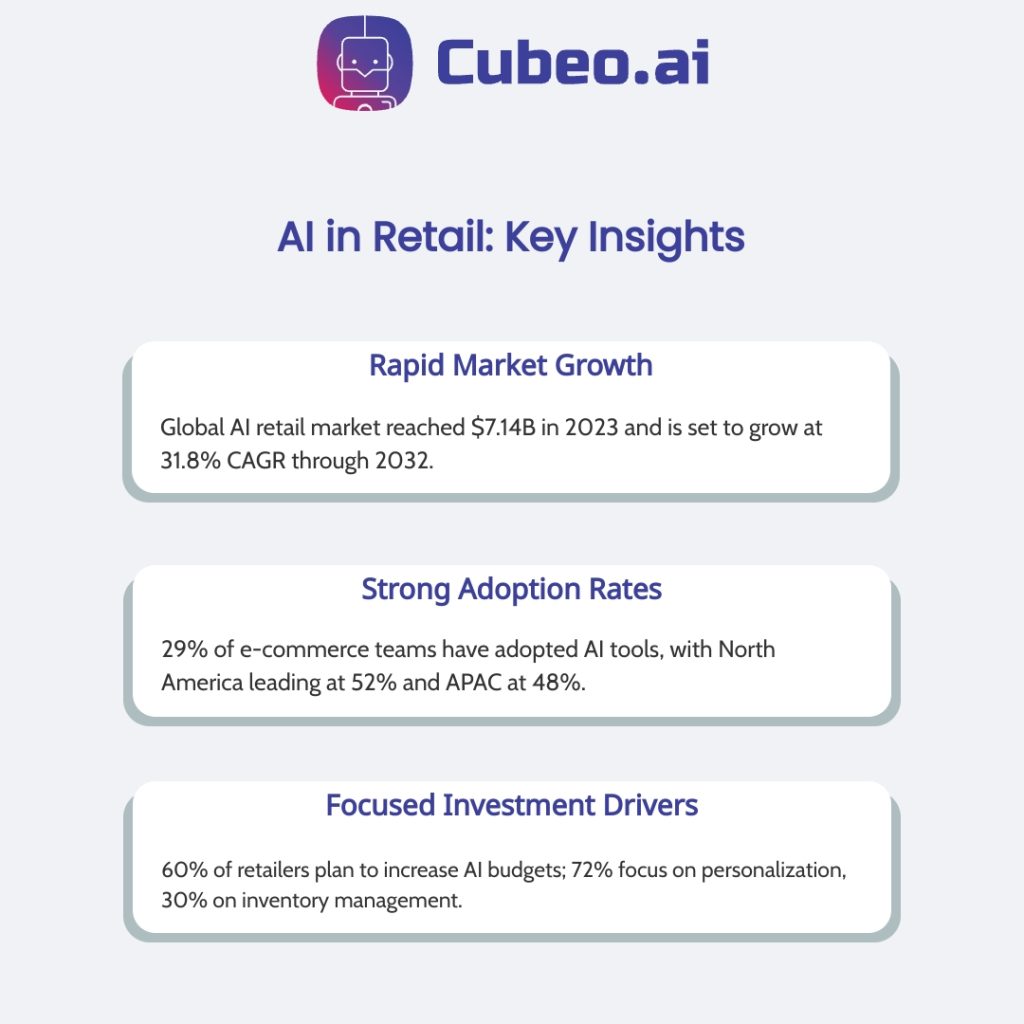
Personalization and product recommendations powered by AI
Shoppers now enjoy curated product selections thanks to AI systems that analyze their unique digital footprints. These smart algorithms process browsing patterns, purchase history, and demographic information to create personalized shopping experiences for each customer.
The financial benefits speak volumes. AI-driven recommendations can boost average order value by up to 22%, with conversion rates climbing 15% on average. Research from Netguru shows personalized suggestions driving a 70% increase in purchase rates and 33% higher basket values.
Behind this success, machine learning engines work continuously by:
- Processing customer data in milliseconds
- Adapting product suggestions in real-time
- Enabling dynamic pricing based on individual behaviors
- Crafting cross-sell opportunities that feel natural
- Reducing cart abandonment by 12%
Customer response to these personalized touches remains overwhelmingly positive. UseInsider data reveals AI-powered personalization can generate a 44% increase in repeat purchases. Approximately 65% of consumers return more frequently when product recommendations align with their preferences. For e-commerce platforms, this technology essentially creates a win-win scenario—customers find products they love while businesses see stronger revenue growth.
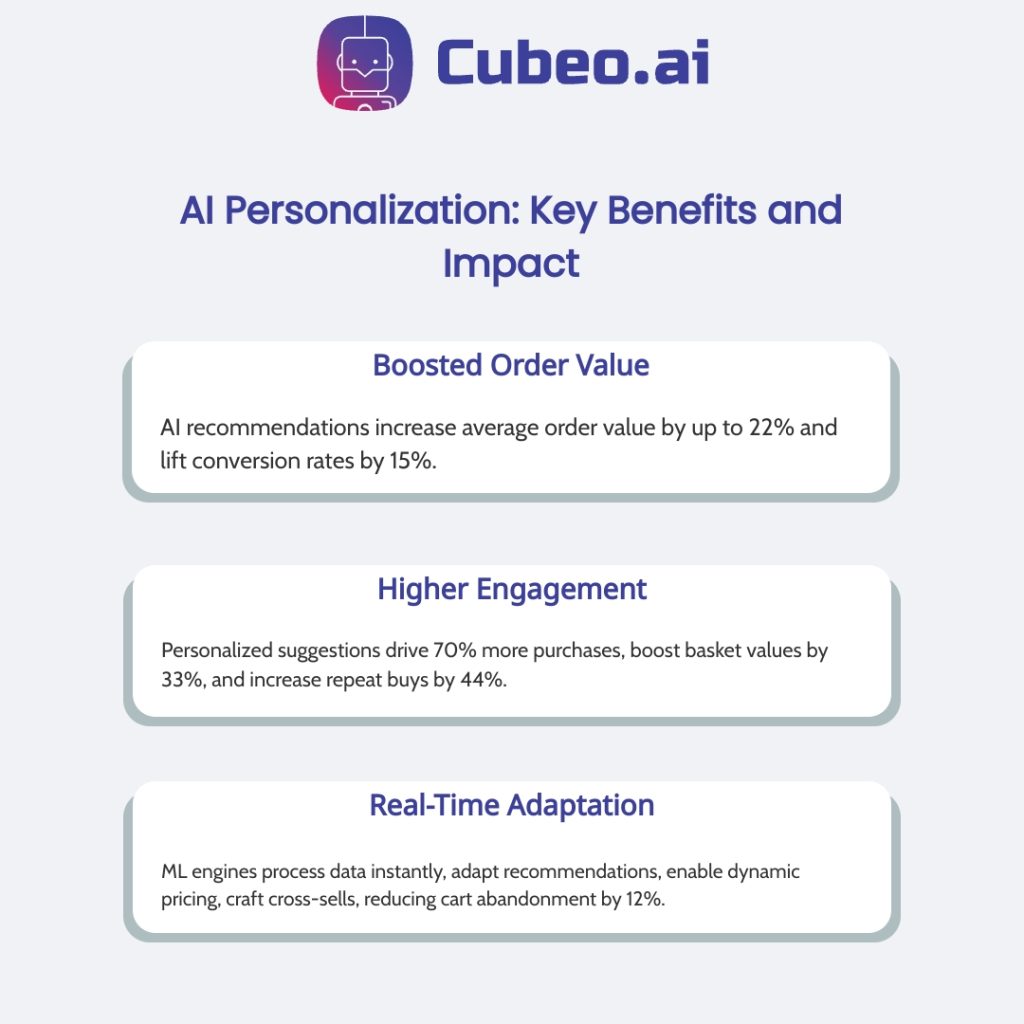
AI-powered chatbots and customer service
Human support teams need rest, but customer questions continue 24/7. AI chatbots fill this gap perfectly, transforming how online stores handle customer service. These digital assistants work continuously, slashing wait times and boosting satisfaction scores.
The numbers tell a compelling story. 40% of customer service queries in retail are now managed by chatbots, with response times dropping by 90%. Recent data shows that AI chatbots can reduce response times by 77% and save businesses over 2.5 billion hours in customer service operations.
These systems do more than just answer questions quickly. Retailers using chatbots see a 14% increase in conversion rates from assisted conversations. The financial benefits extend beyond sales too, as 30% of customer support costs can be saved through chatbot implementation.
AI assistants serve customers throughout their shopping journey:
• Pre-purchase: Answering product questions and suggesting items
• During checkout: Helping complete orders and offering add-ons
• After purchase: Providing tracking info and processing returns
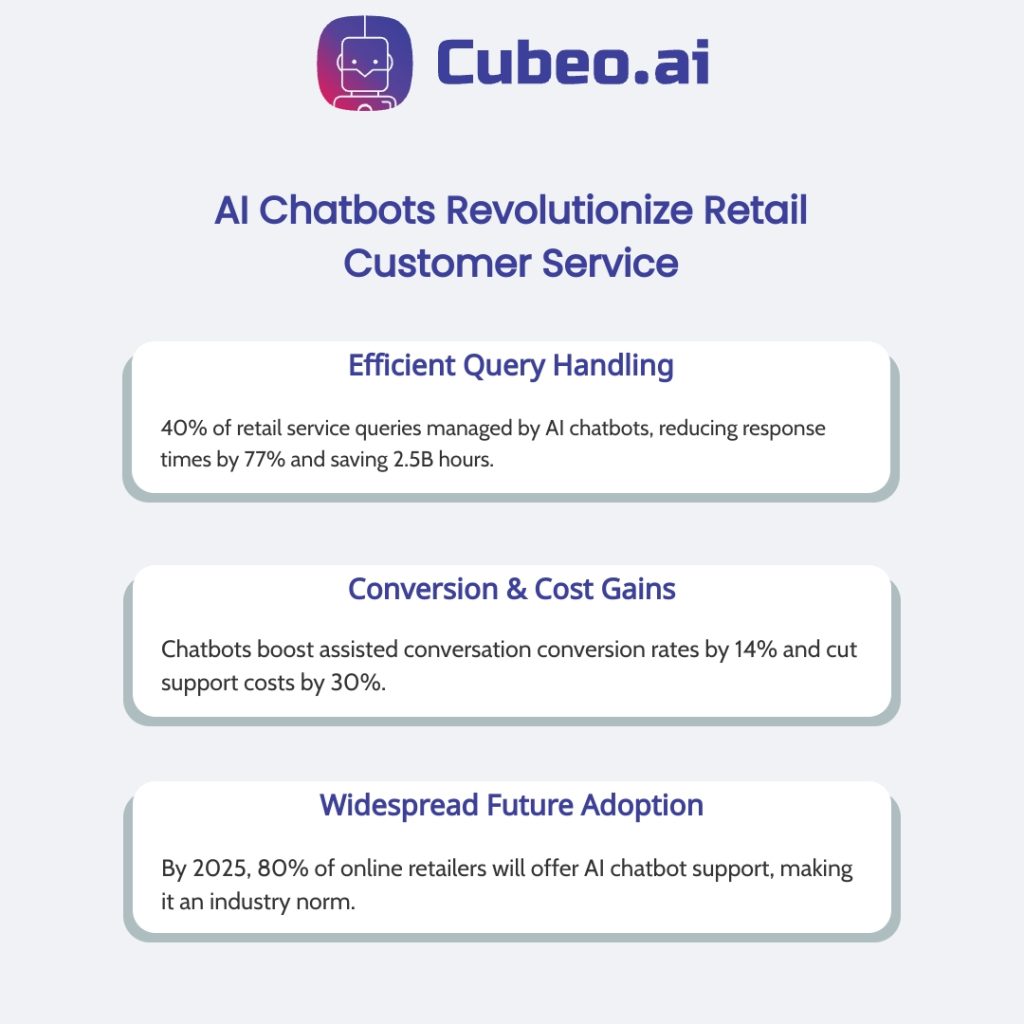
Streamlining supply chain and inventory with AI
E-commerce operations constantly juggle inventory levels, demand predictions, and logistics expenses. AI technology transforms these backend challenges into strategic advantages.
Predictive analytics significantly improves inventory management efficiency. AI-driven supply chain analytics can cut forecasting errors by 50% while reducing operational costs by 20%. According to Forbes research, companies leveraging AI-driven predictive analytics experience fewer stockouts and maintain optimal inventory levels.
Machine learning powers real-time tracking systems that boost stock accuracy by 30%. These systems automatically flag anomalies in inventory patterns, preventing problems before they affect customer experience. AI algorithms continuously monitor supply chains, identifying unusual shipment patterns that might signal disruptions.
Beyond inventory, AI optimizes logistics through smarter route planning and predictive maintenance, reducing fleet downtime by 40%. As noted by Genie, AI-driven inventory optimization substantially lowers holding costs while ensuring products remain available when customers need them.
For e-commerce operations, these AI applications create a positive cycle: better forecasting creates optimal inventory levels, which in turn reduces costs and strengthens customer satisfaction through reliable product availability.
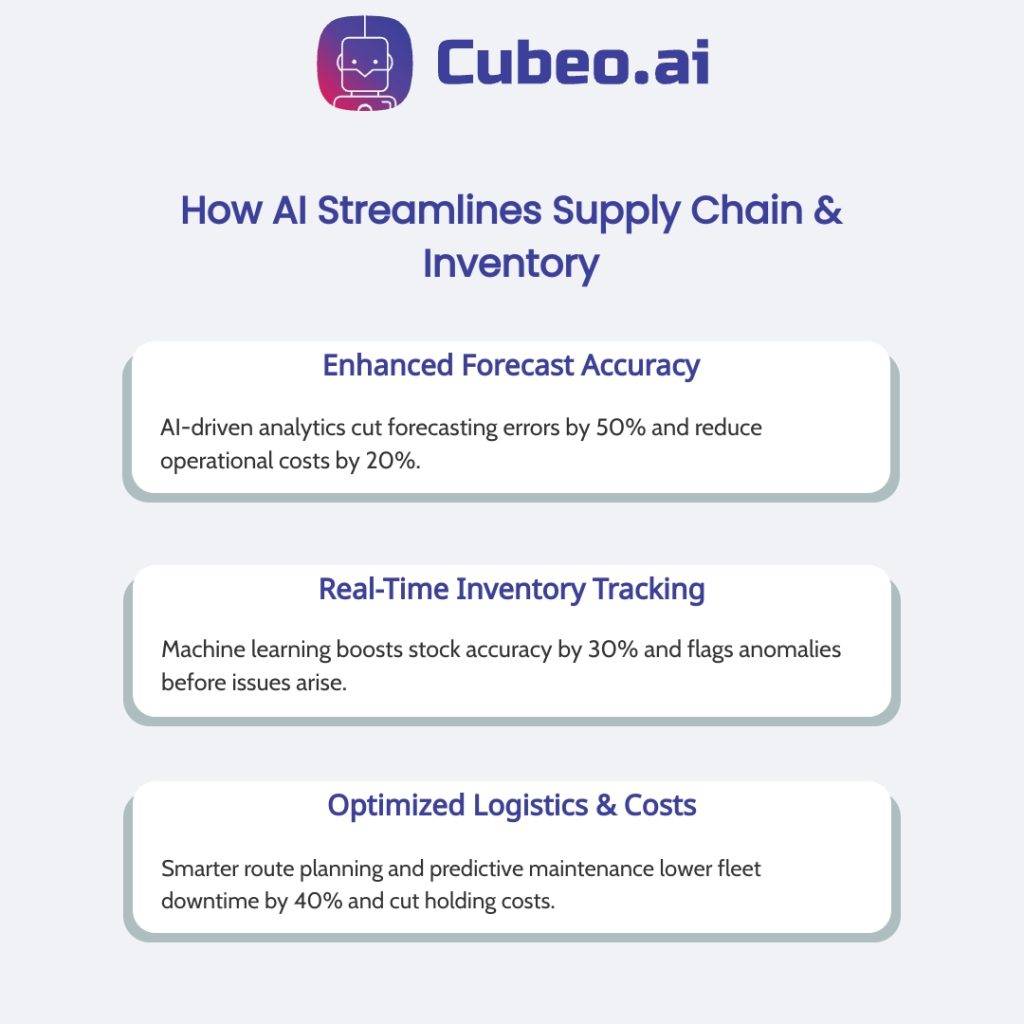
Enhancing marketing automation and SEO with AI
Search engine visibility determines e-commerce success in a landscape that has fundamentally changed. Businesses must now optimize for traditional search engines (SEO) and AI-powered large language models (LEO) simultaneously. This approach requires fresh strategies and innovative tools.
Optimizing content for both Google and AI assistants involves balancing structured data with conversational elements. The Digital Marketing Institute reports 65% of companies have seen improved SEO results through AI tools, while 51% use AI specifically for content optimization. These improvements come from AI analyzing competitive content, identifying semantic gaps, and generating optimized product descriptions at scale.
Effective AI-powered marketing follows systematic workflows:
- Intent mapping across customer journey stages
- Keyword balance between search and conversational queries
- Structured heading hierarchies with clear entity relationships
- Comprehensive metadata and schema markup
- Strategic internal linking patterns
Search Engine Land notes that 82% of consumers find AI-powered search more helpful than traditional methods, highlighting the need to adapt to these technologies. For e-commerce businesses, this shift presents opportunities to reach customers through emerging channels.
Voice search technology and consumer trends
Voice-activated shopping grows rapidly as consumers use smart speakers and mobile voice assistants to research products, compare prices, and make purchases without touching screens.
Amazon Echo and Google Home dominate adoption, with Apple’s Siri gaining market share through mobile devices. Voice queries happen 3.7x faster than typing, creating smoother shopping experiences.
Mobile commerce benefits significantly from voice optimization. Companies implementing voice-friendly product descriptions see conversion rate improvements averaging 30% on mobile devices. This uplift comes from natural alignment between voice search patterns and mobile shopping behavior.
Voice search optimization tactics include:
- Structured data implementation
- Question-based content formatting
- Local search term integration
- Conversational keyword research
Predictive marketing and segmentation
Customer segmentation previously relied on basic demographics and purchase history. AI driven customer segmentation transforms this approach by analyzing hundreds of behavioral signals to create dynamic audience clusters that continuously evolve.
These sophisticated segments power targeted campaigns across channels. Email marketing particularly benefits—AI-segmented campaigns achieve open rates 14.31% higher than traditional methods. SMS campaigns using AI-driven personalization see click-through rates improve by 37%.
The ROI impact proves substantial. Marketers using AI segmentation report up to 15% increases in sales from personalized messaging. This performance boost stems from AI identifying patterns humans might miss.
Implementation follows a straightforward path:
- Connect customer data sources to AI platforms
- Define business objectives and KPIs
- Allow AI to generate initial segments
- Test messaging across segments
- Refine based on performance data
Implementing AI with no-code platforms step by step
Marketing teams can now deploy AI solutions without technical expertise. The no-code AI platform market was valued at USD 3.83 billion in 2023 and will grow to USD 24.42 billion by 2030 at a 30.6% annual rate.
Ready to get started? Follow this roadmap to build your own AI tool without coding skills:
- Set clear objectives – Define specific goals, KPIs, and user personas. In fact, Cubeo AI reports 64% of businesses expect AI to boost efficiency and 25% use AI to address staffing challenges.
- Prepare your data – Collect, clean, and label your information. Quality data creates accurate predictions and recommendations.
- Build your team – Form cross-functional groups including stakeholders from affected departments. No coding skills required!
- Select your approach – Decide between custom infrastructure or no-code platforms. IBM automates over 40% of its internal functions using these solutions.
- Launch and iterate – Start with a basic version, gather feedback, and improve. This approach allows for quick adjustments based on real-world performance.
This framework puts powerful AI capabilities directly in the hands of those who understand customer needs best – your business teams.
Measuring ROI and governance for sustainable AI
Financial reality often tempers AI enthusiasm. Recent data shows enterprise AI projects yield an average ROI of just 5.9%, underscoring why strategic implementation matters. Smart e-commerce operations balance financial discipline with robust governance frameworks.
Comprehensive cost-benefit analyses must account for the full expense spectrum—data preparation, integration, maintenance, and training costs frequently surprise unprepared teams. Research from Cubeo AI reveals 53% of organizations encounter higher-than expected deployment expenses, despite 79% recognizing AI’s competitive necessity.
Focused pilot initiatives deliver measurable wins before broader rollouts. Case studies demonstrate remarkable outcomes, including 55% carbon emission reductions through AI powered grid management and 40% energy savings in data centers. These targeted applications establish clear performance benchmarks.
Sustainable AI governance requires:
- Transparent data privacy protocols and ethical usage guidelines
- Scalable cloud solutions with flexible consumption-based pricing
- Regular performance validation through comparative testing
- Structured feedback mechanisms capturing both system metrics and user experiences
- Quarterly performance reviews against predetermined KPIs
This methodical approach ensures AI delivers sustained value while maintaining ethical standards—a balance increasingly critical as AI capabilities expand across e-commerce operations.
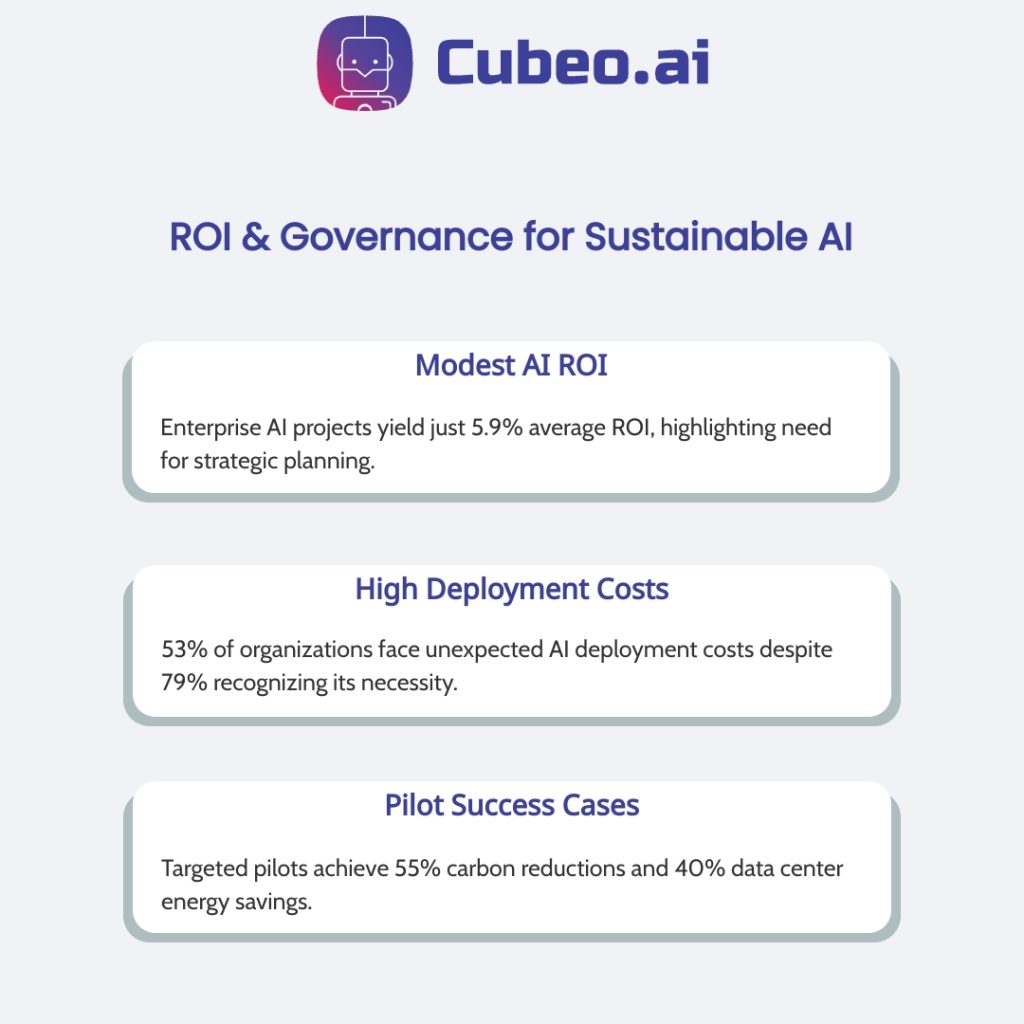
Balancing AI benefits with workflow challenges
A realistic view of AI capabilities helps businesses maximize advantages while addressing potential issues. The AI workflow automation market shows impressive growth, projected to expand from $20.1 billion in 2023 to $78.6 billion by 2030 at a 21.5% CAGR according to Cflow.
The pros and cons of AI workflows create a nuanced landscape for e-commerce operations. On the positive side, AI speeds up tasks, minimizes errors, and works round-the-clock without fatigue. In fact, 54% of organizations now use AI-powered workflows to improve operations.
Yet challenges persist. Many AI systems operate as “black boxes” with unclear decision processes. They need substantial data for training and raise valid privacy concerns when processing customer information.
Successful implementation requires strategic safeguards:
- Human oversight validates quality for customer-facing outputs
- Strong data governance protects sensitive information
- Regular system audits verify decisions against business rules
- Customization adapts tools to existing processes rather than forcing workflow changes
The most effective approach, in a way, combines AI efficiency with human judgment. This balanced strategy preserves automation advantages while maintaining accountability through well-placed human touchpoints.
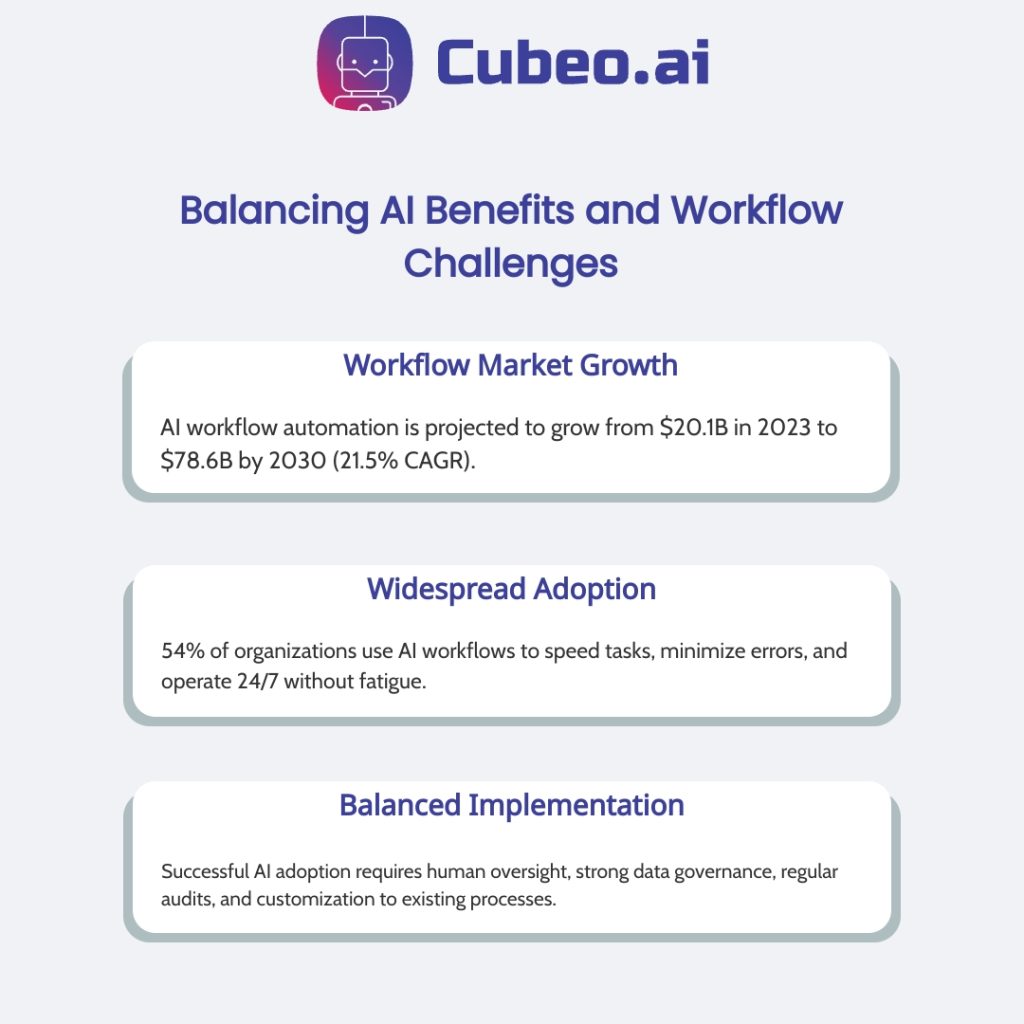
Future trends and predictions in AI for e-commerce
E-commerce businesses face remarkable AI-driven changes in the coming years as technologies mature from basic tools into competitive advantages. Several innovations will define this transformation.
Generative AI leads this revolution by creating product content at scale. McKinsey predicts generative AI will automate up to 30% of content creation tasks in retail by 2027, enabling retailers to produce descriptions and visuals with unprecedented efficiency.
Shopping experiences will become more immersive through technology. AR and VR applications increase conversion rates by 40% with virtual try-ons and product demonstrations. These technologies actually extend customer engagement time by 25% in early implementations.
The financial impact appears substantial—according to recent research, the AI-enabled e commerce market will reach $8.65 billion by the end of 2025, with customers completing purchases 47% faster when assisted by AI. Voice commerce continues gaining momentum, with projections showing AI will handle 80% of all customer interactions by 2030.
Key trends reshaping online retail include:
- Advanced predictive analytics improving demand forecasting by 35%
- Hyper-personalization creating individualized shopping journeys
- IoT devices enabling seamless purchasing across connected environments
- Ethical frameworks becoming essential as regulations evolve
Businesses that embrace responsible AI practices while leveraging these technologies will build lasting customer relationships in this rapidly advancing landscape.
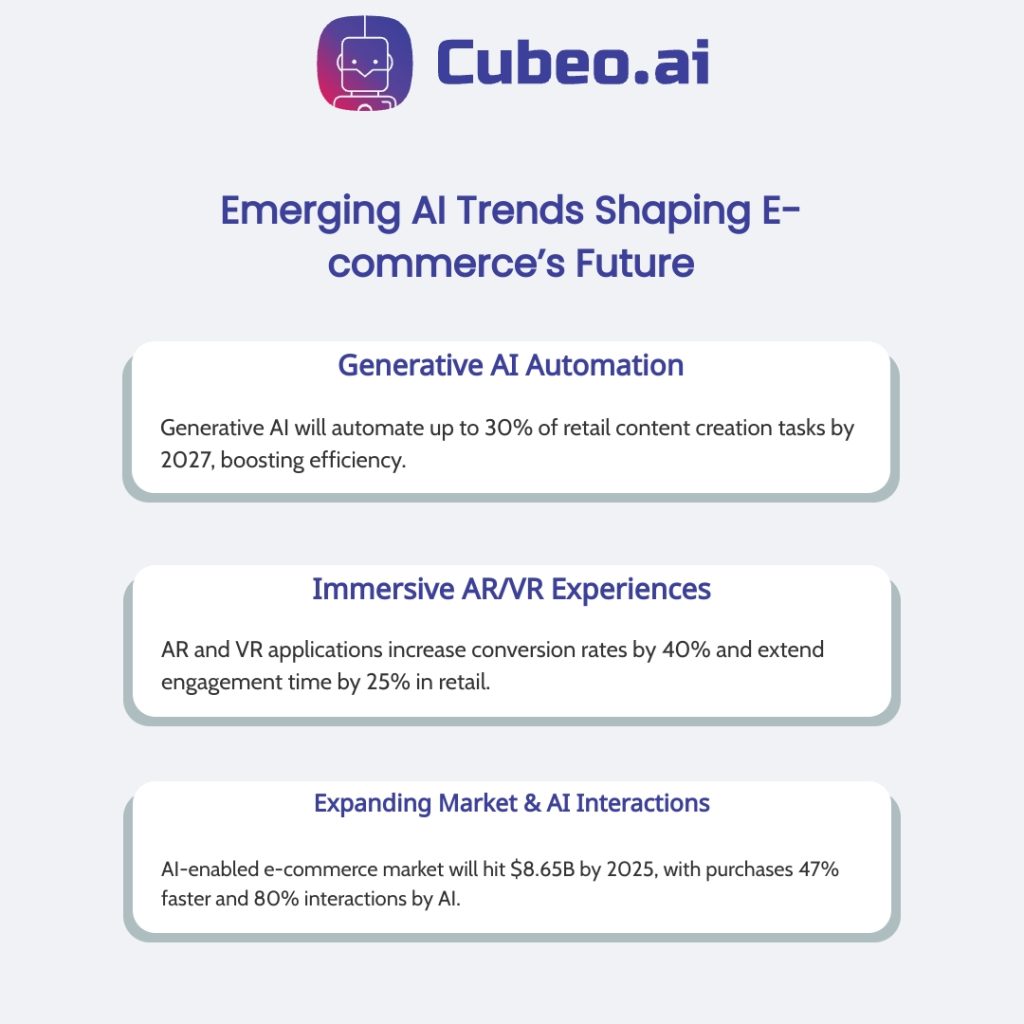
FAQ
How does AI-driven personalization boost online sales?
AI-driven personalization significantly boosts online sales through enhanced customer engagement. It creates shopping experiences tailored to individual preferences, which increases customer satisfaction. Personalized product suggestions can improve conversion rates. This strategy builds customer loyalty and improves market competitiveness.
What are the main challenges of implementing AI in e-commerce operations?
Data privacy and security are leading obstacles when adopting AI in e-commerce. High costs associated with implementation also pose a challenge. Technical integration hurdles and a shortage of skilled talent further complicate AI implementation. Outdated infrastructure can also hinder successful AI integration.
How can small online retailers adopt AI without coding expertise?
Small online retailers can adopt AI through e-commerce platforms like Shopify. These platforms offer pre-built AI tools for tasks like personalized recommendations. AI also helps with inventory management without needing coding skills. AI further automates content creation and optimizes pricing strategies.
What future AI trends should e-commerce leaders watch?
E-commerce leaders should monitor AI trends that drive personalized shopping experiences. Enhancements to customer service and optimized inventory management are also key. AI powered customer service will play a crucial role in improving user experiences. Social commerce offers opportunities for personalized shopping experiences through AI.



